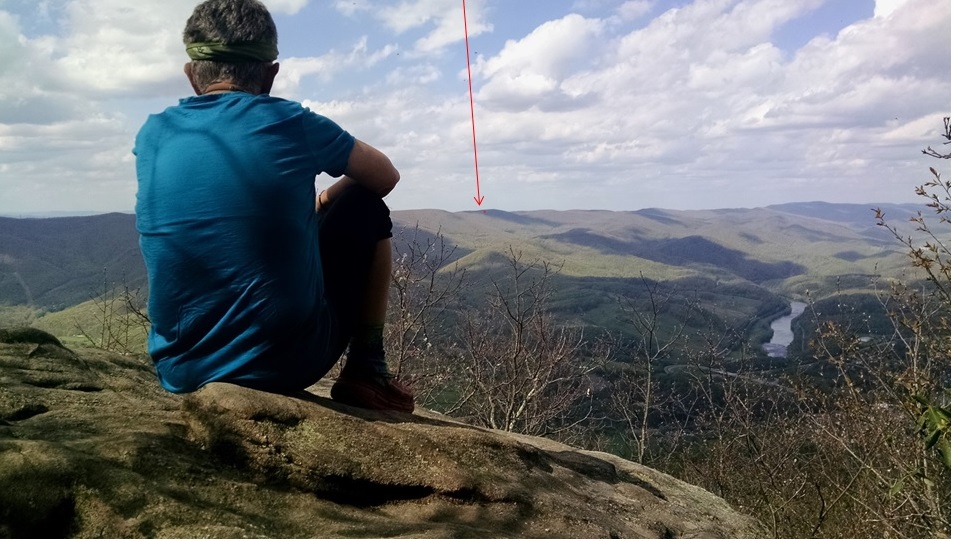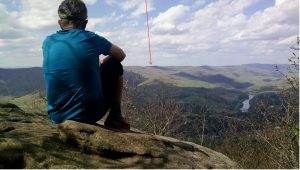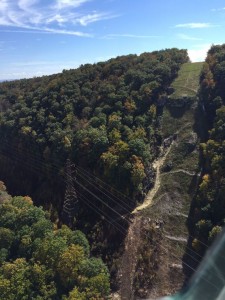RATC Board opposes Mountain Valley Pipeline, citing hiker safety and visual impact

Using criteria developed by the Appalachian Trail Conservancy, the Roanoke Appalachian Trail Club’s board of directors has voted to oppose the Mountain Valley Pipeline due to its potential negative impacts on the AT and trail users. The board’s resolution voices “opposition to construction of the Mountain Valley Pipeline as proposed across the Appalachian Trail on Peters Mountain and in the Appalachian Trail viewshed in numerous locations, including Angel’s Rest and along the Alternate 200 route.” (As already reported on this website, the US Forest Service has raised numerous concerns about the proposed route in its comments to the Federal Energy Regulatory Commission in March 2016.)
Established in 1932 by AT co-founder Myron Avery, the RATC is responsible for over 120 miles of the AT between Route 611 in Giles County and Black Horse Gap on the Blue Ridge Parkway. Club bylaws require the group to support monitoring and managing lands that were purchased for trail protection, to participate in and encourage the development of laws and regulations that protect the AT and its related interests, and to use all legal mans to protect and defend the AT and its related interests.

The board’s resolution cites RATC’s detailed comments to the Federal Energy Regulatory Commission in June 2015 and November 2015, specifically noting the following issues:
- Necessity of compliance with the National Environmental Policy Act of 1970 and the Endangered Species Act of 1973 to examine cumulative impact of all proposed major natural gas pipeline crossings of the Appalachian Trail.
- Avoidance of threats to regional air quality and human health
- Satisfaction of criteria in the Appalachian Trail Conservancy’s 2015 Policy on Pipeline Crossings of the Appalachian Trail.
- Avoidance of threats to regional water supplies and to drinking water for Appalachian Trail hikers
- Avoidance of karst topography and active seismic zones in the proposed AT crossing locations
- Avoidance of specific impacts, including scenic impacts, likely with currently proposed AT crossing alternatives
- Careful and realistic study of visual impacts of the proposed Alternate 200 route, with specific viewpoints and criteria noted in the club’s November 2015 comments.
RATC strongly believes that the pipeline is likely to be visible from numerous locations on the Appalachian Trail and poses potential safety hazards to AT users.
Based on photos taken by RATC members and on a visibility study conducted by Key-Log Economics, RATC believes that the pipeline crossing of Peters Mountain, its route across Mystery Ridge and the New River Valley could be visible for up to 7.2 miles from Angel’s Rest. The pipeline would likely be visible as well from ledges on Pearis Mountain and from Sugar Run Mountain, all in Giles County.

What would it look like? A new 10 to 12 inch pipeline on the same mountain gives a preview on a much smaller scale. The Celanese pipeline in Narrows in highly visible from US 460 and has already experienced serious erosion problems.
Moving north on the AT, the pipeline would be highly visible and pose a safety hazard to AT hikers on Peters Mountain, where the developer proposes to cross the AT with it 42-inch pipeline near Symms Gap Meadow. This location poses numerous very serious challengers for the developer and problems for AT users:
- The pipeline would cross the AT at one of its most scenic points in Virginia and would be visible at many locations on Peters Mountain, including Symms Gap Meadow, the area around Rice Field Shelter, and the Peters Mountain Wilderness.
- The slopes on Peters Mountain, where the developer proposes to cross the AT, are at grades exceeding 40% and even 60% in karst areas with many potential sinkholes located near the center of the Giles County Seismic Zone, scene of the largest earthquake in Virginia history. A study published on July 3, 2015 (“An Expert Report on Geologic Hazards in the Karst Regions of Virginia and West Virginia”) concluded that the route proposed by Mountain Valley Pipeline is a too dangerous for such construction and should be considered a “no-build” zone due to potential impacts on major water supplies for the region and the heightened possibility of a catastrophic failure. The author, Ernst Kastning, is a retired Radford University professor and recognized expert on karst geology.
- As noted in the RATC’s board’s resolution, the proposed crossing of the AT on Peters Mountain “would present a significant safety hazard to AT hikers, since it would contain highly volatile natural gas under 1,440 psig of pressure, located in karst topography near the middle of the Giles County Seismic Zone, scene of the largest earthquake in Virginia’s recorded history. . . The 2014 edition of the Pipeline Association for Public Awareness ‘Pipeline Emergency Response Guidelines’ minimum evacuation distance for natural gas pipeline leaks and ruptures for pipelines of the size (42 inches – largest shown on the guidelines chart) and pressure (1,440 psig) is approximately 3,600 feet – about 0.68 mile on foot. . . AT hikers on Peters Mountain would have to walk miles on steep terrain to evacuate the area around the proposed pipeline. The closest evacuation route – via Pocahontas Road – would take hikers closer to the pipeline rather than away from it. The Groundhog Trail, providing access to the West Virginia side, is over a mile away. There is no sensible evacuation route, and hiker safety does not appear to have been considered in selecting the construction location and method.”
- Natural gas pipelines constructed since 2010 are notably less safe than pipeline built at any time since the 1940s, with two to six times as many dangerous incidents as other pipelines built within the past 60 years. (See Figure 5 in this April 2016 study by the Institute for Energy Economics and Financial Analysis, using public sector and industry data).
The proposed route returns to the AT viewshed when as it enters Craig County in Sinking Creek Valley before crossing Sinking Creek Mountain, Craig Creek, and Brush Mountain.
- The pipeline would be within 1.8 miles of Kelly Knob (#3 on map) as it crosses the valley below and then climbs Sinking Creek Mountain – the location of the largest rock block landslide in North American history and the subject of a US Geological Survey pamphlet, “The Mountain That Moved.”
- It would also be visible from Brush Mountain, including the Brush Mountain Wilderness.
- This segment is particularly noted by Kastning in his analysis of karst topography and his conclusion that it should be a “no build” zone.
- The Virginia Department of Natural Resources has also expressed concerns about construction of the pipeline in the Canoe Cave karst area.
RATC expects to conduct more detailed studies of the potential impacts of the pipeline on the Appalachian Trail, including the strong possibility that several miles of the pipeline would be visible between McAfee Knob and Campbell Shelter if it were permitted to climb the very steep slopes of Poor Mountain in Roanoke County.
